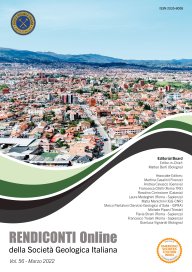
Geological-geomorphological conditioning on the development of the historical centers: the example of Gubbio (Umbria, central Italy)
Ettore A. Sannipoli1 & Corrado Cencetti2
11Independent Researcher.
2Dipartimento di Fisica e Geologia, Università degli Studi di Perugia.
Corresponding author e-mail: corrado.cencetti@unipg.it
DOI: https://doi.org/10.3301/ROL.2022.05
Volume: 56/2022
Pages: 36-44
Abstract
Gubbio (Umbria, central Italy) is located at the foot of Mt. Ingino, which overlooks a large flat area (Gubbio Plain). The Gubbio mountains constitute the NE flank of an anticline broken at the core by a normal fault with high throw (over 1500 m). The debris connecting the slope to the plain area has an evident morphological step (max height about 20 m), expression of neotectonics. When the Eugubins in 12th century built the new city "on the mountain", they identified the area upstream of the escarpment as the most suitable place for the fortified urban space. Later (13th-14th centuries) the development of the city involved an expansion downstream of the urban core, which took the shape of the current historic center. The research in progress on the relationship between development of the late medieval city and conformation of the slope debris on which it was built is aimed at investigating some aspects of an interesting problem of urban geomorphology, relating to a definition of the geomorphological characteristics of the place and the transformations of the urban nucleus in 13th and 14th centuries. It seems interesting to define what these transformations entailed regarding the alterations of the geomorphological peculiarities of the place where the city was born and developed.
Keywords
Get Full Text